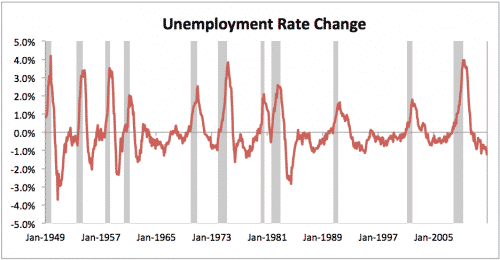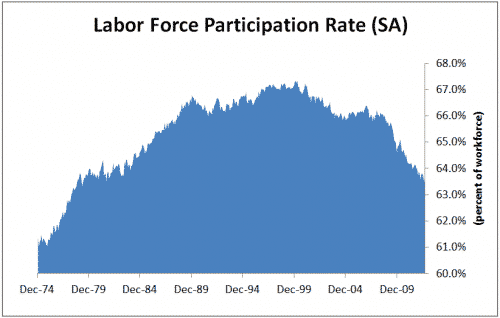Here’s a brief, late Friday post to follow up on the jobs number. If you look at recoveries from past recessions in the United States, what you usually see is a fall in the year-over-year unemployment rate as the economy gathers steam. And this fall gathers steam as the recovery picks up its pace. Clearly, this should make intuitive sense because a recession is a first derivative event; recessions measure the change in employment, income, output, retail sales and GDP not the absolute level.
So to anticipate a change in economic direction or in the pace of economic slowing/acceleration what one has to be looking for in the numbers is a change in the change in the level of those sub-components that point to recession or recovery. For example, when you look at the unemployment rate, what you want to see to confirm continued recovery is a year-on-year change that is stable to rising. If the unemployment rate was 9.1% 15 months ago and it was 8.2% 3 months ago, then you have a 0.9% differential drop. Contrast that then to 12 months ago at 9.0% compared to today at 7.8% and you see a 1.2% drop. That’s a faster drop in the unemployment rate and is not consistent with an economy entering recession. This is what we see in the US right now. Since about November of 2011, we have seen an uptick in the rate of decline in the unemployment rate.
Note: the gray bars mark periods of recession to make it easier to see how the change in the employment rate switches between negative and positive around recessions.
The very big caveat here is that the Labor Participation Rate is declining as people drop out of the labor force. Much of the decline in the rate is attributable to a large number of people leaving the labor force. This makes the unemployment rate suspect and should make one wonder whether the accelerating decline is a real phenomenon or just a statistical one. Many are pointing to this number as a reason to worry that the US is in or near a second recession.
My view is that we are not in or near a second recession, but that the fiscal cliff will push us in that direction when a large number of cuts and tax hikes come together at the same time. For now, the story is weak but steady growth, something that puts the US near stall speed and makes it vulnerable to exogenous shocks. But US growth far exceeds the economic trajectory in the euro zone periphery and the UK where economies also suffered comparable housing booms and busts. If anything, I am starting to upgrade my assessment of the US economy and see the fiscal cliff as the only major impediment to growth.


Comments are closed.